Strategic Human Resource Management and Workforce Diversity at ASDA
VerifiedAdded on 2020/12/09
|9
|2966
|244
Report
AI Summary
This report delves into the critical relationship between strategic human resource management (SHRM) and workforce diversity, focusing on its impact on organisational culture, using ASDA as a case study. The introduction outlines the project's aim to analyze this impact, setting objectives to understand workforce diversity, its importance, and its effects on ASDA's culture, along with ways to positively incorporate diversity. The literature review synthesizes existing research, highlighting the significance of SHRM in managing workforce diversity, considering the challenges arising from diverse backgrounds and the influence of organisational culture. The research methodology section discusses primary data collection methods, including interviews, questionnaires, and observations, to gather relevant data. Ethical considerations are addressed, emphasizing the importance of ethical guidelines in research to ensure transparency, fairness, and reliability. The report aims to provide insights into how organisations like ASDA can effectively manage their human resources, reduce diversity-related issues, and foster a supportive culture to achieve their goals.
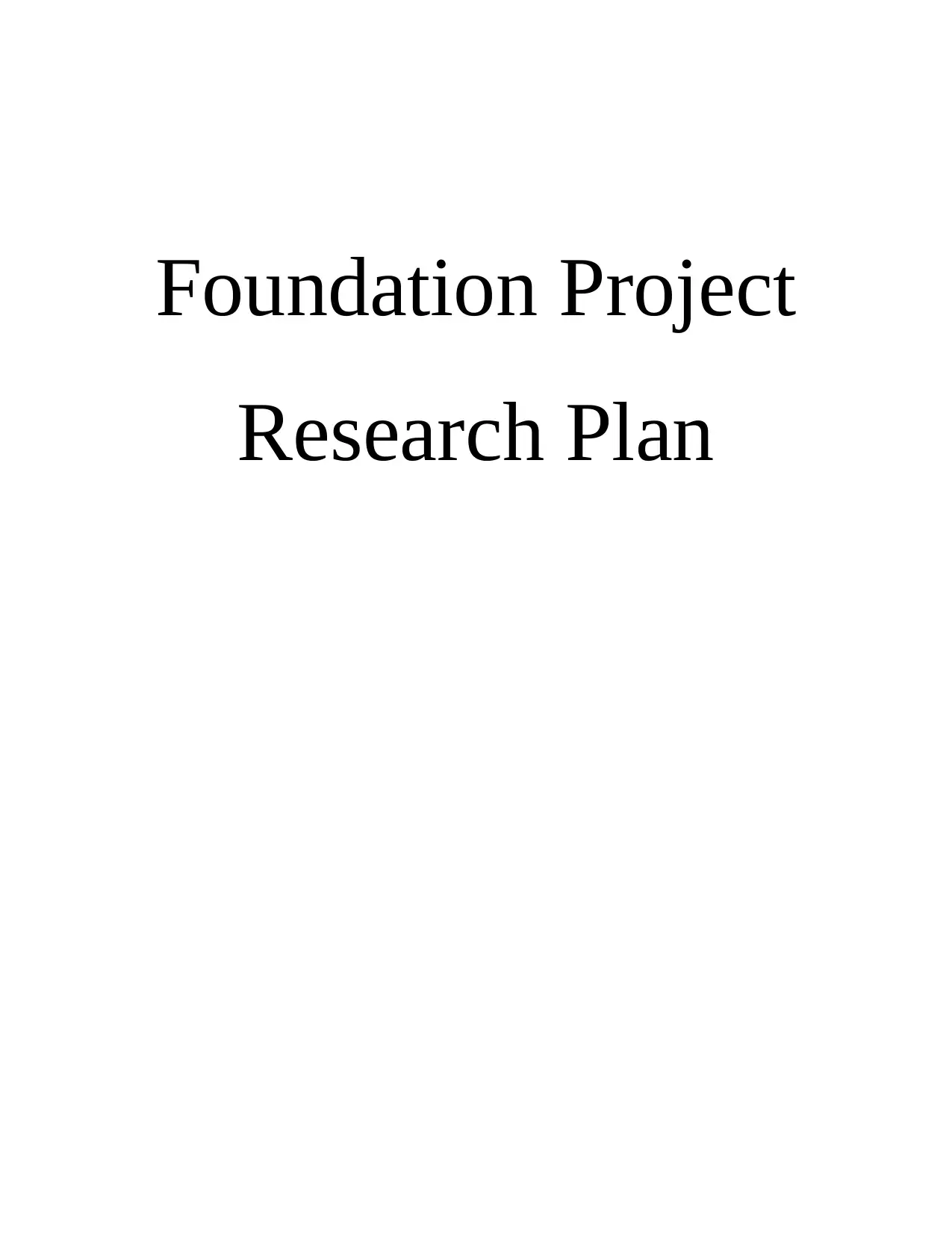
Foundation Project
Research Plan
Research Plan
Paraphrase This Document
Need a fresh take? Get an instant paraphrase of this document with our AI Paraphraser
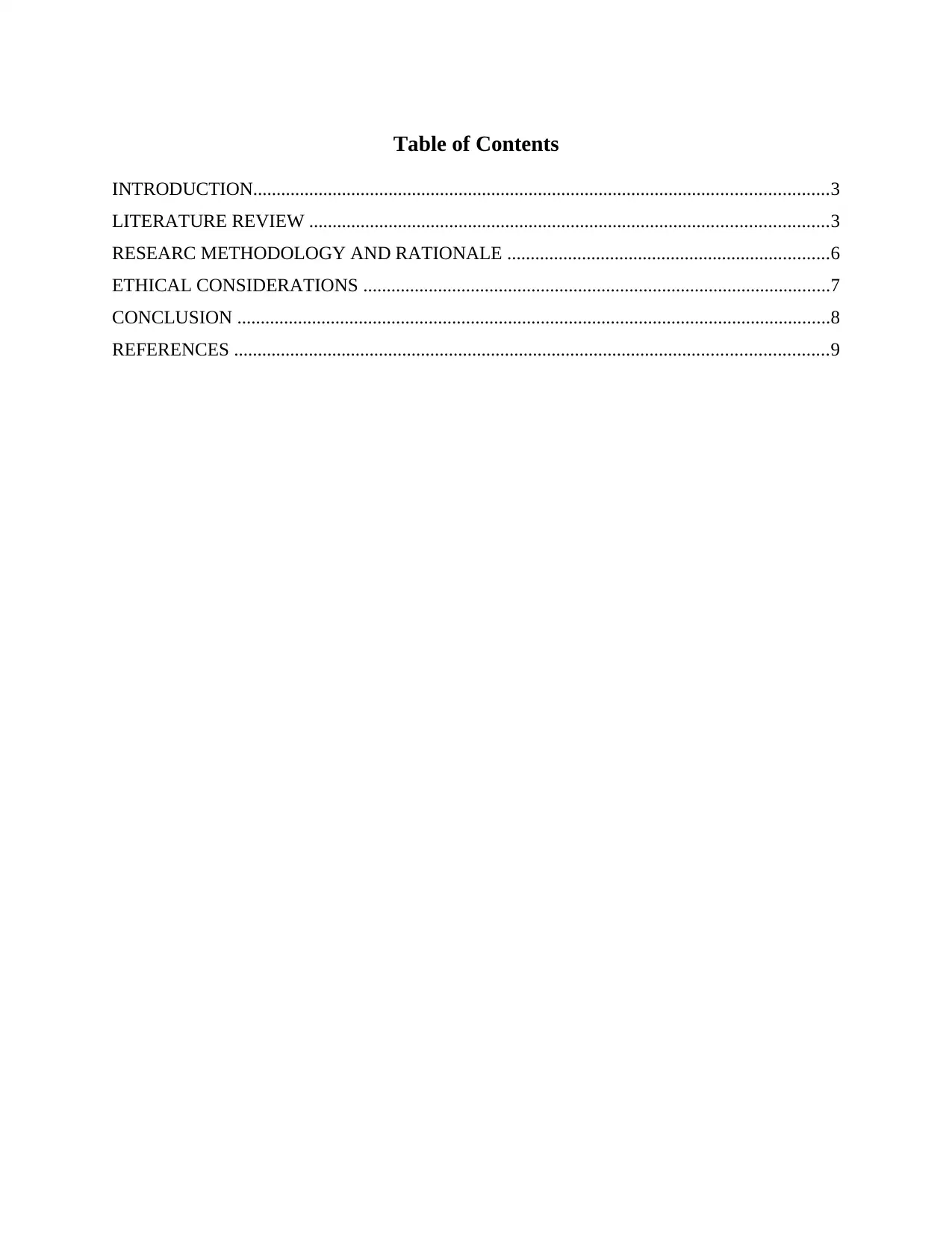
Table of Contents
INTRODUCTION...........................................................................................................................3
LITERATURE REVIEW ...............................................................................................................3
RESEARC METHODOLOGY AND RATIONALE .....................................................................6
ETHICAL CONSIDERATIONS ....................................................................................................7
CONCLUSION ...............................................................................................................................8
REFERENCES ...............................................................................................................................9
INTRODUCTION...........................................................................................................................3
LITERATURE REVIEW ...............................................................................................................3
RESEARC METHODOLOGY AND RATIONALE .....................................................................6
ETHICAL CONSIDERATIONS ....................................................................................................7
CONCLUSION ...............................................................................................................................8
REFERENCES ...............................................................................................................................9
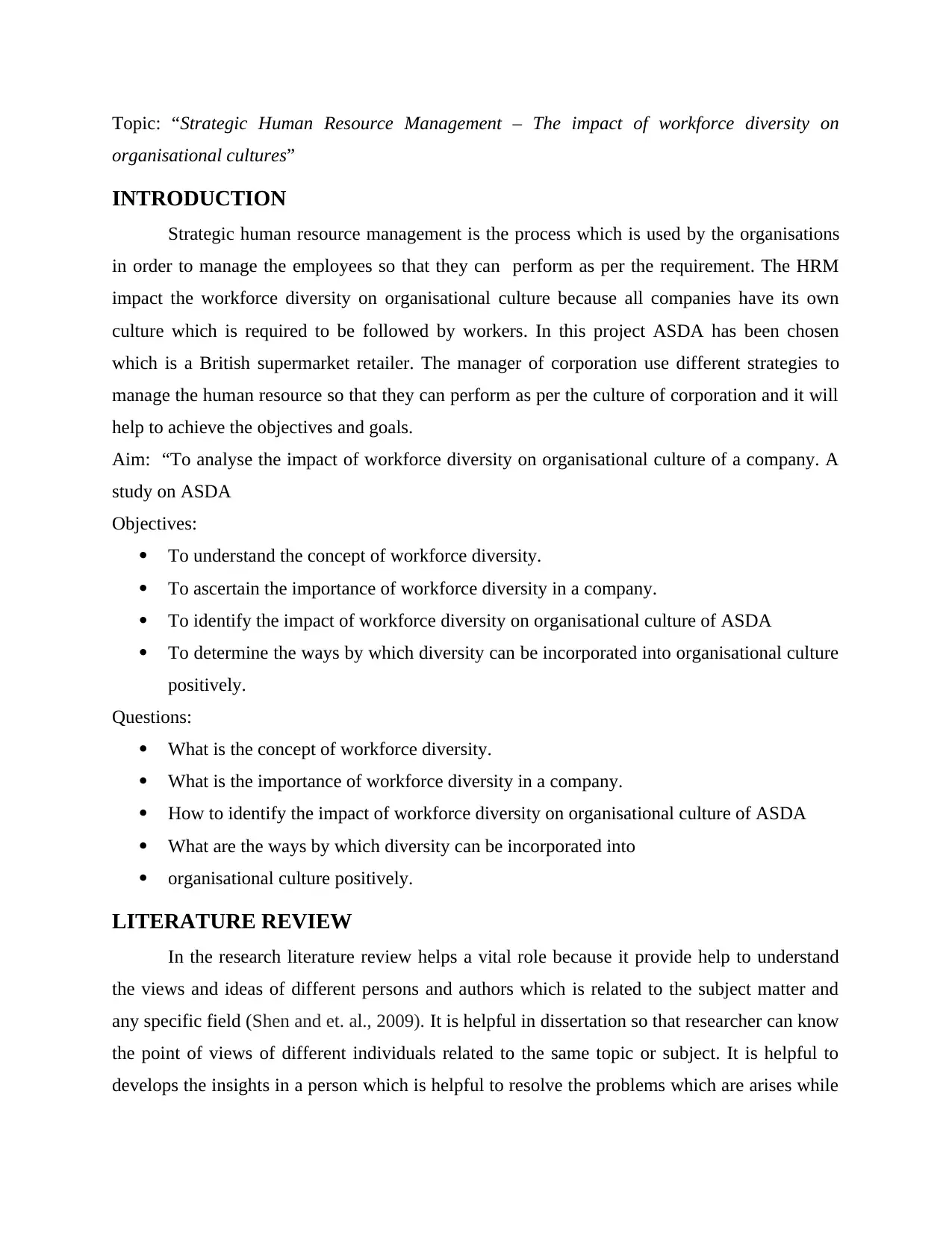
Topic: “Strategic Human Resource Management – The impact of workforce diversity on
organisational cultures”
INTRODUCTION
Strategic human resource management is the process which is used by the organisations
in order to manage the employees so that they can perform as per the requirement. The HRM
impact the workforce diversity on organisational culture because all companies have its own
culture which is required to be followed by workers. In this project ASDA has been chosen
which is a British supermarket retailer. The manager of corporation use different strategies to
manage the human resource so that they can perform as per the culture of corporation and it will
help to achieve the objectives and goals.
Aim: “To analyse the impact of workforce diversity on organisational culture of a company. A
study on ASDA
Objectives:
To understand the concept of workforce diversity.
To ascertain the importance of workforce diversity in a company.
To identify the impact of workforce diversity on organisational culture of ASDA
To determine the ways by which diversity can be incorporated into organisational culture
positively.
Questions:
What is the concept of workforce diversity.
What is the importance of workforce diversity in a company.
How to identify the impact of workforce diversity on organisational culture of ASDA
What are the ways by which diversity can be incorporated into
organisational culture positively.
LITERATURE REVIEW
In the research literature review helps a vital role because it provide help to understand
the views and ideas of different persons and authors which is related to the subject matter and
any specific field (Shen and et. al., 2009). It is helpful in dissertation so that researcher can know
the point of views of different individuals related to the same topic or subject. It is helpful to
develops the insights in a person which is helpful to resolve the problems which are arises while
organisational cultures”
INTRODUCTION
Strategic human resource management is the process which is used by the organisations
in order to manage the employees so that they can perform as per the requirement. The HRM
impact the workforce diversity on organisational culture because all companies have its own
culture which is required to be followed by workers. In this project ASDA has been chosen
which is a British supermarket retailer. The manager of corporation use different strategies to
manage the human resource so that they can perform as per the culture of corporation and it will
help to achieve the objectives and goals.
Aim: “To analyse the impact of workforce diversity on organisational culture of a company. A
study on ASDA
Objectives:
To understand the concept of workforce diversity.
To ascertain the importance of workforce diversity in a company.
To identify the impact of workforce diversity on organisational culture of ASDA
To determine the ways by which diversity can be incorporated into organisational culture
positively.
Questions:
What is the concept of workforce diversity.
What is the importance of workforce diversity in a company.
How to identify the impact of workforce diversity on organisational culture of ASDA
What are the ways by which diversity can be incorporated into
organisational culture positively.
LITERATURE REVIEW
In the research literature review helps a vital role because it provide help to understand
the views and ideas of different persons and authors which is related to the subject matter and
any specific field (Shen and et. al., 2009). It is helpful in dissertation so that researcher can know
the point of views of different individuals related to the same topic or subject. It is helpful to
develops the insights in a person which is helpful to resolve the problems which are arises while
⊘ This is a preview!⊘
Do you want full access?
Subscribe today to unlock all pages.

Trusted by 1+ million students worldwide
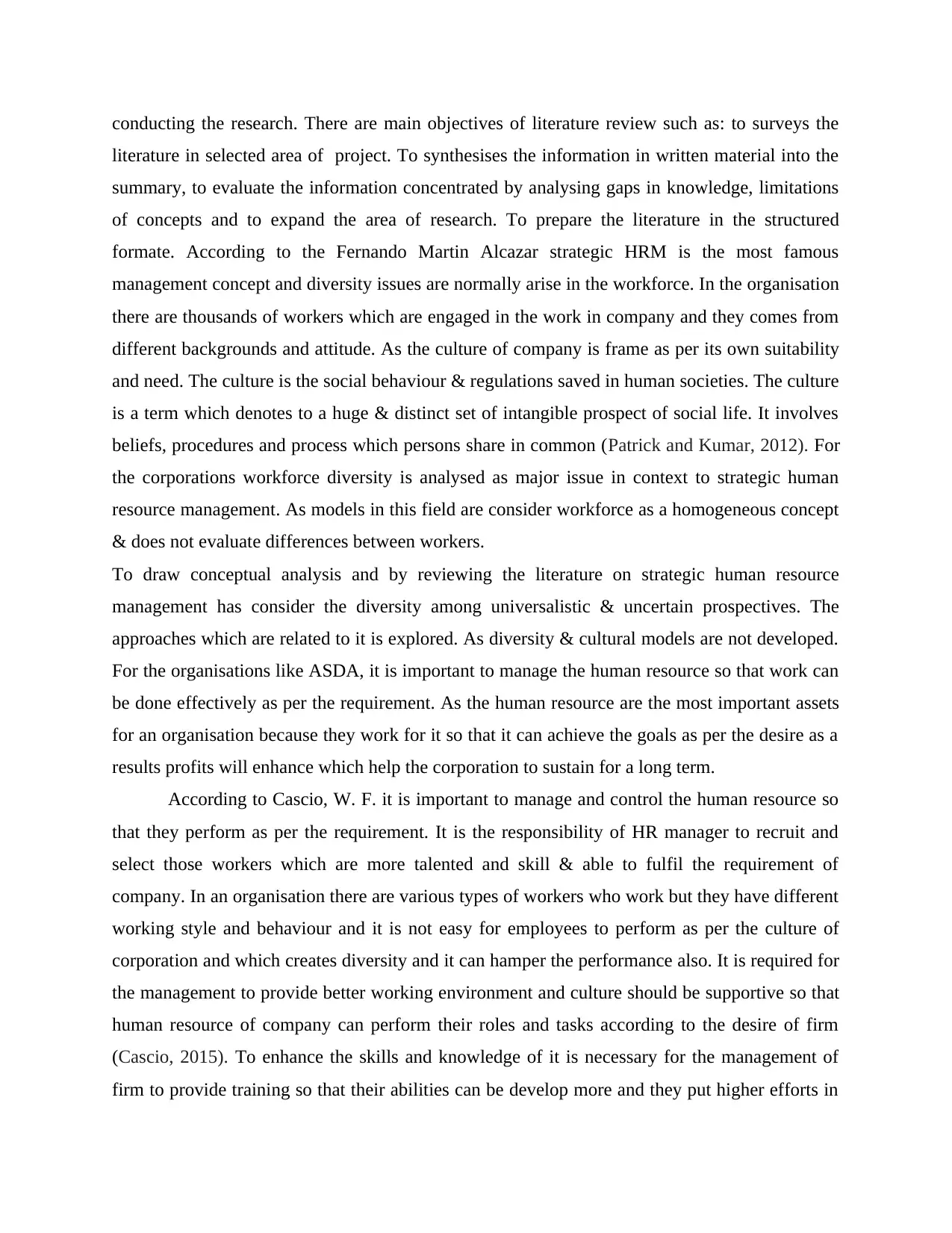
conducting the research. There are main objectives of literature review such as: to surveys the
literature in selected area of project. To synthesises the information in written material into the
summary, to evaluate the information concentrated by analysing gaps in knowledge, limitations
of concepts and to expand the area of research. To prepare the literature in the structured
formate. According to the Fernando Martin Alcazar strategic HRM is the most famous
management concept and diversity issues are normally arise in the workforce. In the organisation
there are thousands of workers which are engaged in the work in company and they comes from
different backgrounds and attitude. As the culture of company is frame as per its own suitability
and need. The culture is the social behaviour & regulations saved in human societies. The culture
is a term which denotes to a huge & distinct set of intangible prospect of social life. It involves
beliefs, procedures and process which persons share in common (Patrick and Kumar, 2012). For
the corporations workforce diversity is analysed as major issue in context to strategic human
resource management. As models in this field are consider workforce as a homogeneous concept
& does not evaluate differences between workers.
To draw conceptual analysis and by reviewing the literature on strategic human resource
management has consider the diversity among universalistic & uncertain prospectives. The
approaches which are related to it is explored. As diversity & cultural models are not developed.
For the organisations like ASDA, it is important to manage the human resource so that work can
be done effectively as per the requirement. As the human resource are the most important assets
for an organisation because they work for it so that it can achieve the goals as per the desire as a
results profits will enhance which help the corporation to sustain for a long term.
According to Cascio, W. F. it is important to manage and control the human resource so
that they perform as per the requirement. It is the responsibility of HR manager to recruit and
select those workers which are more talented and skill & able to fulfil the requirement of
company. In an organisation there are various types of workers who work but they have different
working style and behaviour and it is not easy for employees to perform as per the culture of
corporation and which creates diversity and it can hamper the performance also. It is required for
the management to provide better working environment and culture should be supportive so that
human resource of company can perform their roles and tasks according to the desire of firm
(Cascio, 2015). To enhance the skills and knowledge of it is necessary for the management of
firm to provide training so that their abilities can be develop more and they put higher efforts in
literature in selected area of project. To synthesises the information in written material into the
summary, to evaluate the information concentrated by analysing gaps in knowledge, limitations
of concepts and to expand the area of research. To prepare the literature in the structured
formate. According to the Fernando Martin Alcazar strategic HRM is the most famous
management concept and diversity issues are normally arise in the workforce. In the organisation
there are thousands of workers which are engaged in the work in company and they comes from
different backgrounds and attitude. As the culture of company is frame as per its own suitability
and need. The culture is the social behaviour & regulations saved in human societies. The culture
is a term which denotes to a huge & distinct set of intangible prospect of social life. It involves
beliefs, procedures and process which persons share in common (Patrick and Kumar, 2012). For
the corporations workforce diversity is analysed as major issue in context to strategic human
resource management. As models in this field are consider workforce as a homogeneous concept
& does not evaluate differences between workers.
To draw conceptual analysis and by reviewing the literature on strategic human resource
management has consider the diversity among universalistic & uncertain prospectives. The
approaches which are related to it is explored. As diversity & cultural models are not developed.
For the organisations like ASDA, it is important to manage the human resource so that work can
be done effectively as per the requirement. As the human resource are the most important assets
for an organisation because they work for it so that it can achieve the goals as per the desire as a
results profits will enhance which help the corporation to sustain for a long term.
According to Cascio, W. F. it is important to manage and control the human resource so
that they perform as per the requirement. It is the responsibility of HR manager to recruit and
select those workers which are more talented and skill & able to fulfil the requirement of
company. In an organisation there are various types of workers who work but they have different
working style and behaviour and it is not easy for employees to perform as per the culture of
corporation and which creates diversity and it can hamper the performance also. It is required for
the management to provide better working environment and culture should be supportive so that
human resource of company can perform their roles and tasks according to the desire of firm
(Cascio, 2015). To enhance the skills and knowledge of it is necessary for the management of
firm to provide training so that their abilities can be develop more and they put higher efforts in
Paraphrase This Document
Need a fresh take? Get an instant paraphrase of this document with our AI Paraphraser
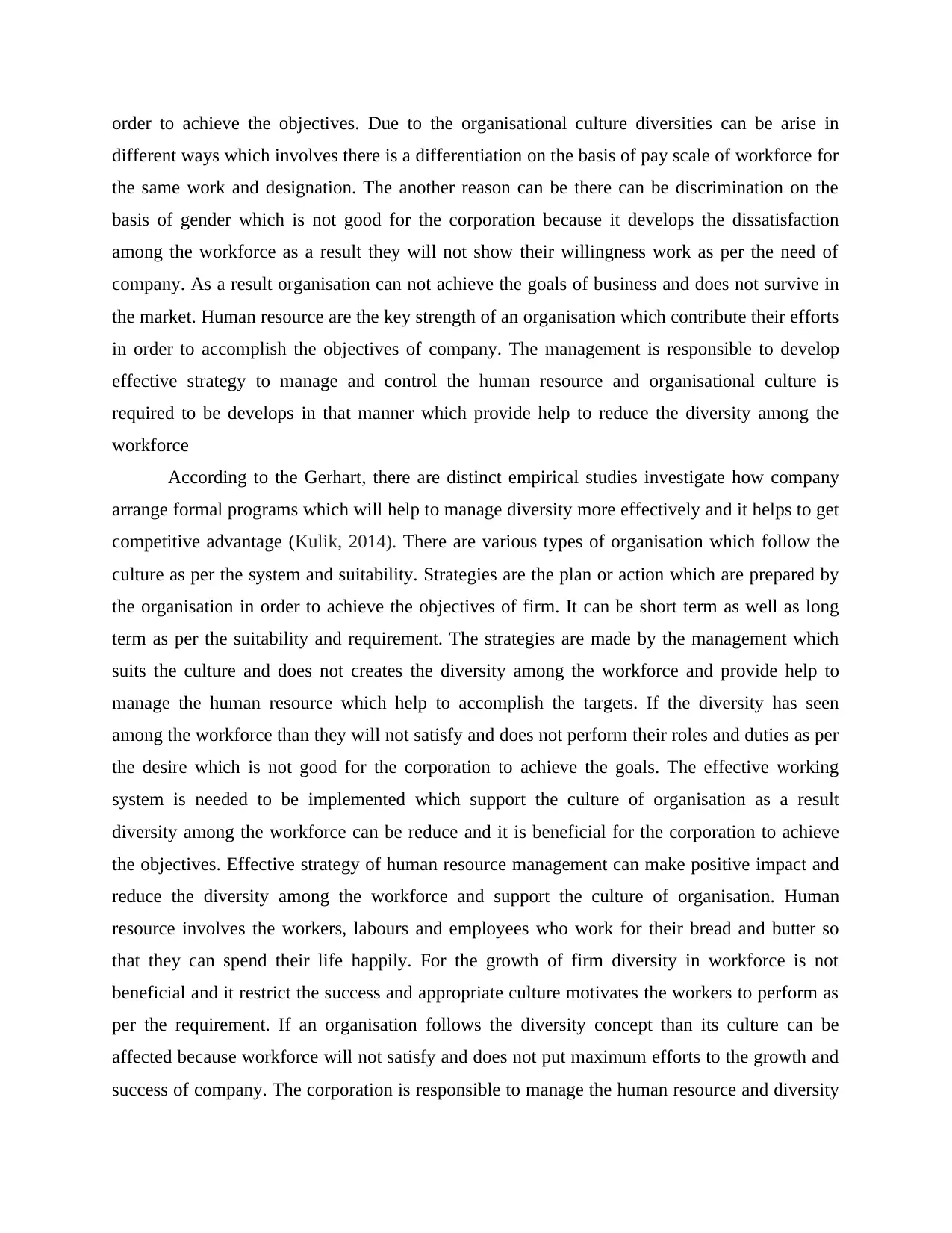
order to achieve the objectives. Due to the organisational culture diversities can be arise in
different ways which involves there is a differentiation on the basis of pay scale of workforce for
the same work and designation. The another reason can be there can be discrimination on the
basis of gender which is not good for the corporation because it develops the dissatisfaction
among the workforce as a result they will not show their willingness work as per the need of
company. As a result organisation can not achieve the goals of business and does not survive in
the market. Human resource are the key strength of an organisation which contribute their efforts
in order to accomplish the objectives of company. The management is responsible to develop
effective strategy to manage and control the human resource and organisational culture is
required to be develops in that manner which provide help to reduce the diversity among the
workforce
According to the Gerhart, there are distinct empirical studies investigate how company
arrange formal programs which will help to manage diversity more effectively and it helps to get
competitive advantage (Kulik, 2014). There are various types of organisation which follow the
culture as per the system and suitability. Strategies are the plan or action which are prepared by
the organisation in order to achieve the objectives of firm. It can be short term as well as long
term as per the suitability and requirement. The strategies are made by the management which
suits the culture and does not creates the diversity among the workforce and provide help to
manage the human resource which help to accomplish the targets. If the diversity has seen
among the workforce than they will not satisfy and does not perform their roles and duties as per
the desire which is not good for the corporation to achieve the goals. The effective working
system is needed to be implemented which support the culture of organisation as a result
diversity among the workforce can be reduce and it is beneficial for the corporation to achieve
the objectives. Effective strategy of human resource management can make positive impact and
reduce the diversity among the workforce and support the culture of organisation. Human
resource involves the workers, labours and employees who work for their bread and butter so
that they can spend their life happily. For the growth of firm diversity in workforce is not
beneficial and it restrict the success and appropriate culture motivates the workers to perform as
per the requirement. If an organisation follows the diversity concept than its culture can be
affected because workforce will not satisfy and does not put maximum efforts to the growth and
success of company. The corporation is responsible to manage the human resource and diversity
different ways which involves there is a differentiation on the basis of pay scale of workforce for
the same work and designation. The another reason can be there can be discrimination on the
basis of gender which is not good for the corporation because it develops the dissatisfaction
among the workforce as a result they will not show their willingness work as per the need of
company. As a result organisation can not achieve the goals of business and does not survive in
the market. Human resource are the key strength of an organisation which contribute their efforts
in order to accomplish the objectives of company. The management is responsible to develop
effective strategy to manage and control the human resource and organisational culture is
required to be develops in that manner which provide help to reduce the diversity among the
workforce
According to the Gerhart, there are distinct empirical studies investigate how company
arrange formal programs which will help to manage diversity more effectively and it helps to get
competitive advantage (Kulik, 2014). There are various types of organisation which follow the
culture as per the system and suitability. Strategies are the plan or action which are prepared by
the organisation in order to achieve the objectives of firm. It can be short term as well as long
term as per the suitability and requirement. The strategies are made by the management which
suits the culture and does not creates the diversity among the workforce and provide help to
manage the human resource which help to accomplish the targets. If the diversity has seen
among the workforce than they will not satisfy and does not perform their roles and duties as per
the desire which is not good for the corporation to achieve the goals. The effective working
system is needed to be implemented which support the culture of organisation as a result
diversity among the workforce can be reduce and it is beneficial for the corporation to achieve
the objectives. Effective strategy of human resource management can make positive impact and
reduce the diversity among the workforce and support the culture of organisation. Human
resource involves the workers, labours and employees who work for their bread and butter so
that they can spend their life happily. For the growth of firm diversity in workforce is not
beneficial and it restrict the success and appropriate culture motivates the workers to perform as
per the requirement. If an organisation follows the diversity concept than its culture can be
affected because workforce will not satisfy and does not put maximum efforts to the growth and
success of company. The corporation is responsible to manage the human resource and diversity
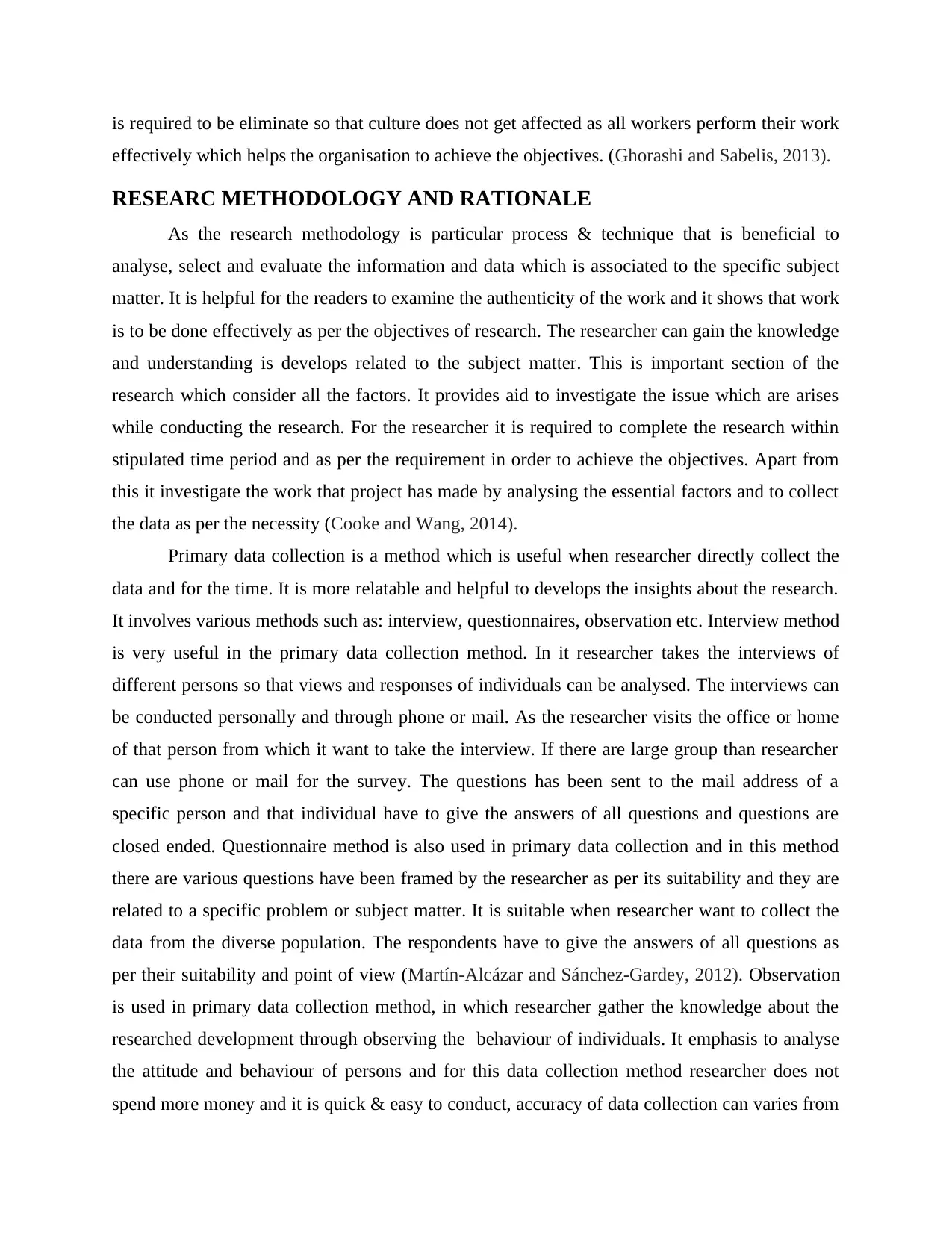
is required to be eliminate so that culture does not get affected as all workers perform their work
effectively which helps the organisation to achieve the objectives. (Ghorashi and Sabelis, 2013).
RESEARC METHODOLOGY AND RATIONALE
As the research methodology is particular process & technique that is beneficial to
analyse, select and evaluate the information and data which is associated to the specific subject
matter. It is helpful for the readers to examine the authenticity of the work and it shows that work
is to be done effectively as per the objectives of research. The researcher can gain the knowledge
and understanding is develops related to the subject matter. This is important section of the
research which consider all the factors. It provides aid to investigate the issue which are arises
while conducting the research. For the researcher it is required to complete the research within
stipulated time period and as per the requirement in order to achieve the objectives. Apart from
this it investigate the work that project has made by analysing the essential factors and to collect
the data as per the necessity (Cooke and Wang, 2014).
Primary data collection is a method which is useful when researcher directly collect the
data and for the time. It is more relatable and helpful to develops the insights about the research.
It involves various methods such as: interview, questionnaires, observation etc. Interview method
is very useful in the primary data collection method. In it researcher takes the interviews of
different persons so that views and responses of individuals can be analysed. The interviews can
be conducted personally and through phone or mail. As the researcher visits the office or home
of that person from which it want to take the interview. If there are large group than researcher
can use phone or mail for the survey. The questions has been sent to the mail address of a
specific person and that individual have to give the answers of all questions and questions are
closed ended. Questionnaire method is also used in primary data collection and in this method
there are various questions have been framed by the researcher as per its suitability and they are
related to a specific problem or subject matter. It is suitable when researcher want to collect the
data from the diverse population. The respondents have to give the answers of all questions as
per their suitability and point of view (Martín-Alcázar and Sánchez-Gardey, 2012). Observation
is used in primary data collection method, in which researcher gather the knowledge about the
researched development through observing the behaviour of individuals. It emphasis to analyse
the attitude and behaviour of persons and for this data collection method researcher does not
spend more money and it is quick & easy to conduct, accuracy of data collection can varies from
effectively which helps the organisation to achieve the objectives. (Ghorashi and Sabelis, 2013).
RESEARC METHODOLOGY AND RATIONALE
As the research methodology is particular process & technique that is beneficial to
analyse, select and evaluate the information and data which is associated to the specific subject
matter. It is helpful for the readers to examine the authenticity of the work and it shows that work
is to be done effectively as per the objectives of research. The researcher can gain the knowledge
and understanding is develops related to the subject matter. This is important section of the
research which consider all the factors. It provides aid to investigate the issue which are arises
while conducting the research. For the researcher it is required to complete the research within
stipulated time period and as per the requirement in order to achieve the objectives. Apart from
this it investigate the work that project has made by analysing the essential factors and to collect
the data as per the necessity (Cooke and Wang, 2014).
Primary data collection is a method which is useful when researcher directly collect the
data and for the time. It is more relatable and helpful to develops the insights about the research.
It involves various methods such as: interview, questionnaires, observation etc. Interview method
is very useful in the primary data collection method. In it researcher takes the interviews of
different persons so that views and responses of individuals can be analysed. The interviews can
be conducted personally and through phone or mail. As the researcher visits the office or home
of that person from which it want to take the interview. If there are large group than researcher
can use phone or mail for the survey. The questions has been sent to the mail address of a
specific person and that individual have to give the answers of all questions and questions are
closed ended. Questionnaire method is also used in primary data collection and in this method
there are various questions have been framed by the researcher as per its suitability and they are
related to a specific problem or subject matter. It is suitable when researcher want to collect the
data from the diverse population. The respondents have to give the answers of all questions as
per their suitability and point of view (Martín-Alcázar and Sánchez-Gardey, 2012). Observation
is used in primary data collection method, in which researcher gather the knowledge about the
researched development through observing the behaviour of individuals. It emphasis to analyse
the attitude and behaviour of persons and for this data collection method researcher does not
spend more money and it is quick & easy to conduct, accuracy of data collection can varies from
⊘ This is a preview!⊘
Do you want full access?
Subscribe today to unlock all pages.

Trusted by 1+ million students worldwide
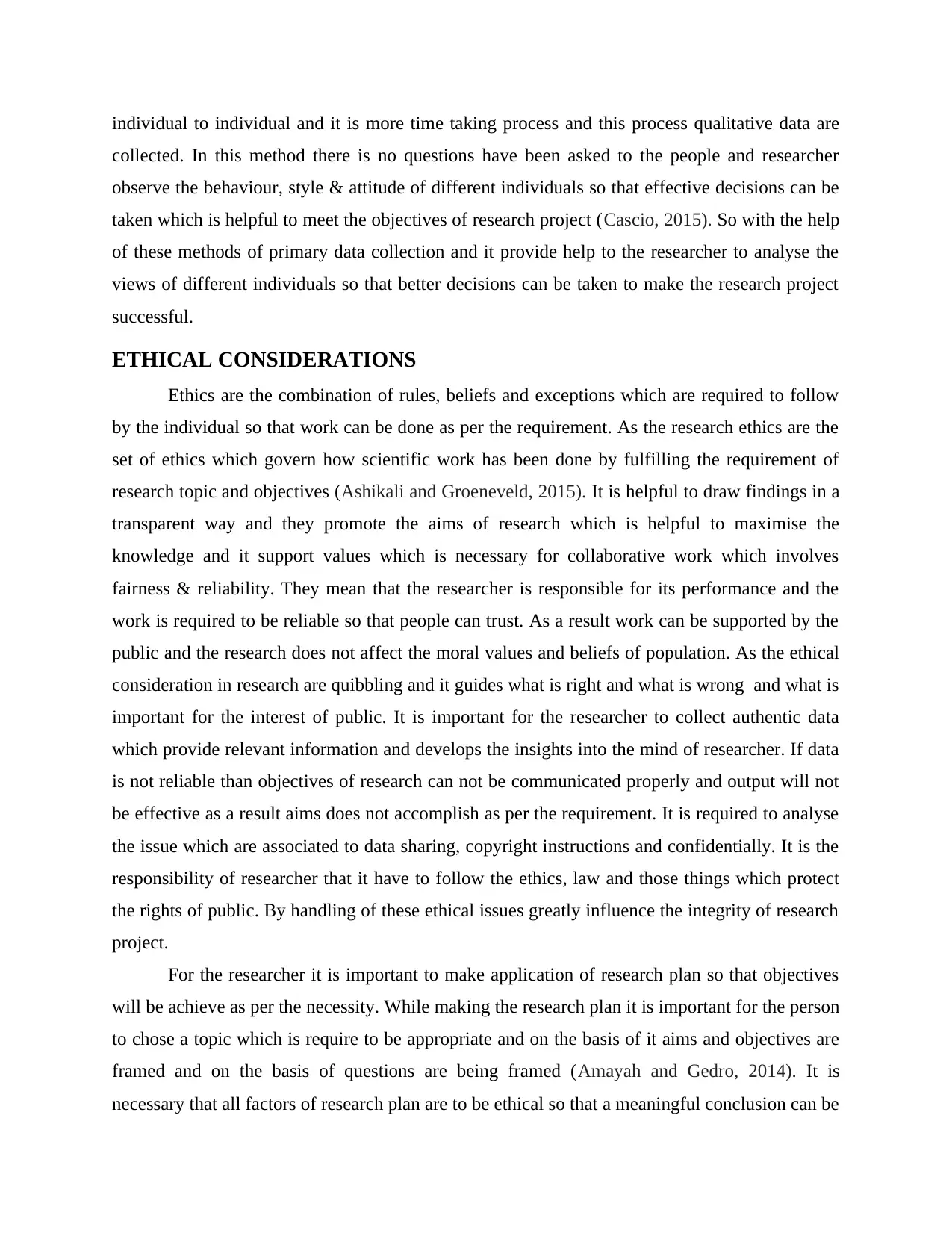
individual to individual and it is more time taking process and this process qualitative data are
collected. In this method there is no questions have been asked to the people and researcher
observe the behaviour, style & attitude of different individuals so that effective decisions can be
taken which is helpful to meet the objectives of research project (Cascio, 2015). So with the help
of these methods of primary data collection and it provide help to the researcher to analyse the
views of different individuals so that better decisions can be taken to make the research project
successful.
ETHICAL CONSIDERATIONS
Ethics are the combination of rules, beliefs and exceptions which are required to follow
by the individual so that work can be done as per the requirement. As the research ethics are the
set of ethics which govern how scientific work has been done by fulfilling the requirement of
research topic and objectives (Ashikali and Groeneveld, 2015). It is helpful to draw findings in a
transparent way and they promote the aims of research which is helpful to maximise the
knowledge and it support values which is necessary for collaborative work which involves
fairness & reliability. They mean that the researcher is responsible for its performance and the
work is required to be reliable so that people can trust. As a result work can be supported by the
public and the research does not affect the moral values and beliefs of population. As the ethical
consideration in research are quibbling and it guides what is right and what is wrong and what is
important for the interest of public. It is important for the researcher to collect authentic data
which provide relevant information and develops the insights into the mind of researcher. If data
is not reliable than objectives of research can not be communicated properly and output will not
be effective as a result aims does not accomplish as per the requirement. It is required to analyse
the issue which are associated to data sharing, copyright instructions and confidentially. It is the
responsibility of researcher that it have to follow the ethics, law and those things which protect
the rights of public. By handling of these ethical issues greatly influence the integrity of research
project.
For the researcher it is important to make application of research plan so that objectives
will be achieve as per the necessity. While making the research plan it is important for the person
to chose a topic which is require to be appropriate and on the basis of it aims and objectives are
framed and on the basis of questions are being framed (Amayah and Gedro, 2014). It is
necessary that all factors of research plan are to be ethical so that a meaningful conclusion can be
collected. In this method there is no questions have been asked to the people and researcher
observe the behaviour, style & attitude of different individuals so that effective decisions can be
taken which is helpful to meet the objectives of research project (Cascio, 2015). So with the help
of these methods of primary data collection and it provide help to the researcher to analyse the
views of different individuals so that better decisions can be taken to make the research project
successful.
ETHICAL CONSIDERATIONS
Ethics are the combination of rules, beliefs and exceptions which are required to follow
by the individual so that work can be done as per the requirement. As the research ethics are the
set of ethics which govern how scientific work has been done by fulfilling the requirement of
research topic and objectives (Ashikali and Groeneveld, 2015). It is helpful to draw findings in a
transparent way and they promote the aims of research which is helpful to maximise the
knowledge and it support values which is necessary for collaborative work which involves
fairness & reliability. They mean that the researcher is responsible for its performance and the
work is required to be reliable so that people can trust. As a result work can be supported by the
public and the research does not affect the moral values and beliefs of population. As the ethical
consideration in research are quibbling and it guides what is right and what is wrong and what is
important for the interest of public. It is important for the researcher to collect authentic data
which provide relevant information and develops the insights into the mind of researcher. If data
is not reliable than objectives of research can not be communicated properly and output will not
be effective as a result aims does not accomplish as per the requirement. It is required to analyse
the issue which are associated to data sharing, copyright instructions and confidentially. It is the
responsibility of researcher that it have to follow the ethics, law and those things which protect
the rights of public. By handling of these ethical issues greatly influence the integrity of research
project.
For the researcher it is important to make application of research plan so that objectives
will be achieve as per the necessity. While making the research plan it is important for the person
to chose a topic which is require to be appropriate and on the basis of it aims and objectives are
framed and on the basis of questions are being framed (Amayah and Gedro, 2014). It is
necessary that all factors of research plan are to be ethical so that a meaningful conclusion can be
Paraphrase This Document
Need a fresh take? Get an instant paraphrase of this document with our AI Paraphraser
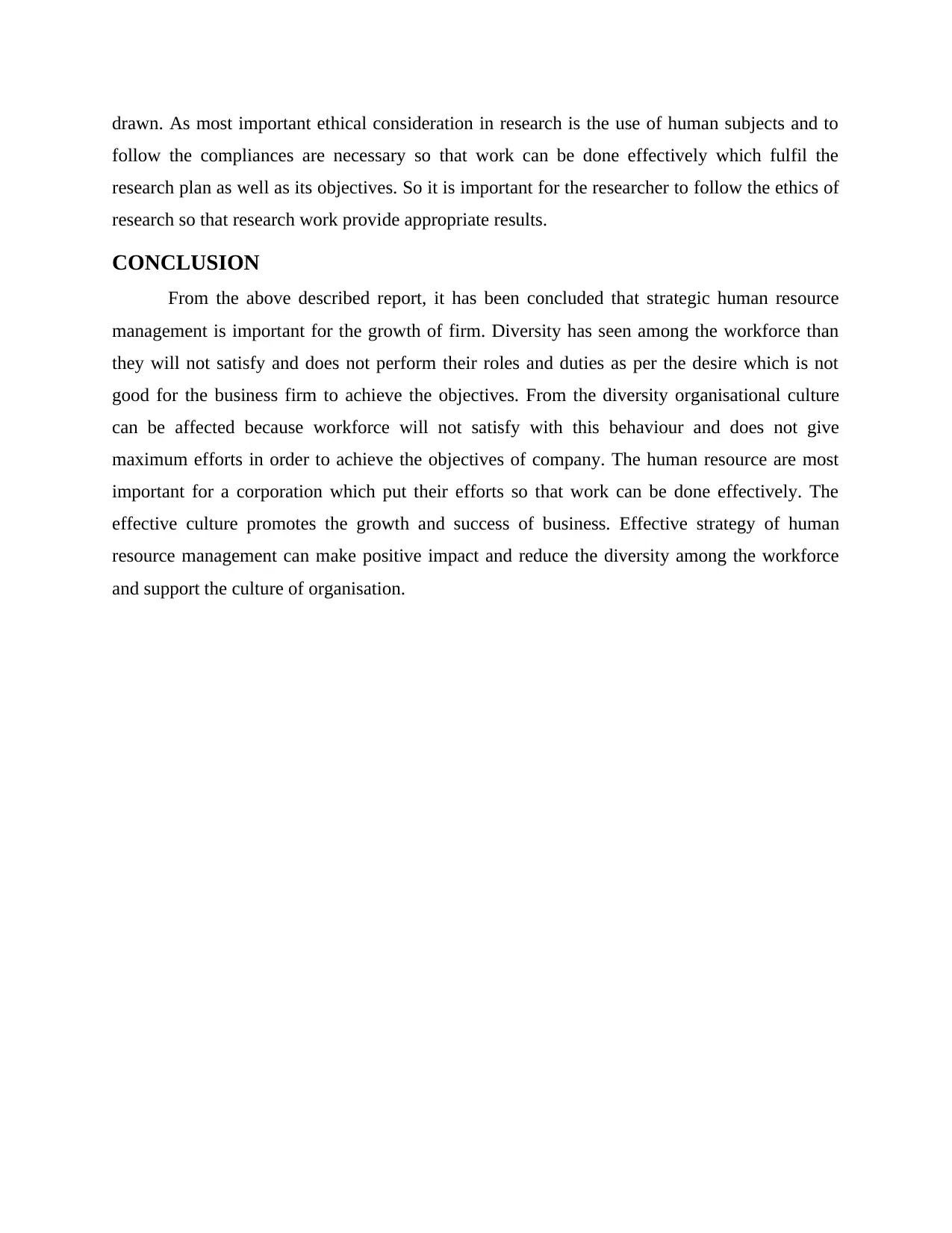
drawn. As most important ethical consideration in research is the use of human subjects and to
follow the compliances are necessary so that work can be done effectively which fulfil the
research plan as well as its objectives. So it is important for the researcher to follow the ethics of
research so that research work provide appropriate results.
CONCLUSION
From the above described report, it has been concluded that strategic human resource
management is important for the growth of firm. Diversity has seen among the workforce than
they will not satisfy and does not perform their roles and duties as per the desire which is not
good for the business firm to achieve the objectives. From the diversity organisational culture
can be affected because workforce will not satisfy with this behaviour and does not give
maximum efforts in order to achieve the objectives of company. The human resource are most
important for a corporation which put their efforts so that work can be done effectively. The
effective culture promotes the growth and success of business. Effective strategy of human
resource management can make positive impact and reduce the diversity among the workforce
and support the culture of organisation.
follow the compliances are necessary so that work can be done effectively which fulfil the
research plan as well as its objectives. So it is important for the researcher to follow the ethics of
research so that research work provide appropriate results.
CONCLUSION
From the above described report, it has been concluded that strategic human resource
management is important for the growth of firm. Diversity has seen among the workforce than
they will not satisfy and does not perform their roles and duties as per the desire which is not
good for the business firm to achieve the objectives. From the diversity organisational culture
can be affected because workforce will not satisfy with this behaviour and does not give
maximum efforts in order to achieve the objectives of company. The human resource are most
important for a corporation which put their efforts so that work can be done effectively. The
effective culture promotes the growth and success of business. Effective strategy of human
resource management can make positive impact and reduce the diversity among the workforce
and support the culture of organisation.
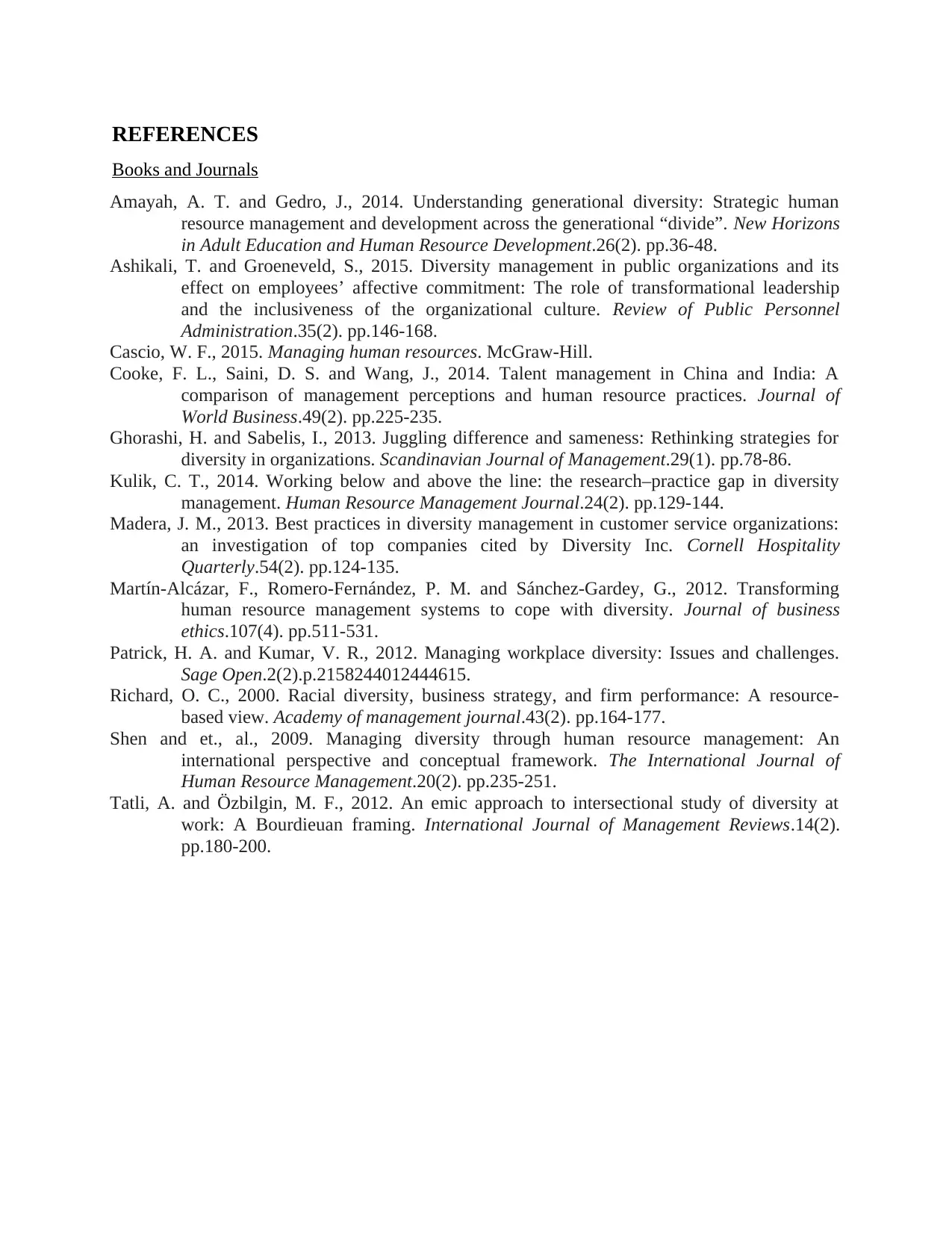
REFERENCES
Books and Journals
Amayah, A. T. and Gedro, J., 2014. Understanding generational diversity: Strategic human
resource management and development across the generational “divide”. New Horizons
in Adult Education and Human Resource Development.26(2). pp.36-48.
Ashikali, T. and Groeneveld, S., 2015. Diversity management in public organizations and its
effect on employees’ affective commitment: The role of transformational leadership
and the inclusiveness of the organizational culture. Review of Public Personnel
Administration.35(2). pp.146-168.
Cascio, W. F., 2015. Managing human resources. McGraw-Hill.
Cooke, F. L., Saini, D. S. and Wang, J., 2014. Talent management in China and India: A
comparison of management perceptions and human resource practices. Journal of
World Business.49(2). pp.225-235.
Ghorashi, H. and Sabelis, I., 2013. Juggling difference and sameness: Rethinking strategies for
diversity in organizations. Scandinavian Journal of Management.29(1). pp.78-86.
Kulik, C. T., 2014. Working below and above the line: the research–practice gap in diversity
management. Human Resource Management Journal.24(2). pp.129-144.
Madera, J. M., 2013. Best practices in diversity management in customer service organizations:
an investigation of top companies cited by Diversity Inc. Cornell Hospitality
Quarterly.54(2). pp.124-135.
Martín-Alcázar, F., Romero-Fernández, P. M. and Sánchez-Gardey, G., 2012. Transforming
human resource management systems to cope with diversity. Journal of business
ethics.107(4). pp.511-531.
Patrick, H. A. and Kumar, V. R., 2012. Managing workplace diversity: Issues and challenges.
Sage Open.2(2).p.2158244012444615.
Richard, O. C., 2000. Racial diversity, business strategy, and firm performance: A resource-
based view. Academy of management journal.43(2). pp.164-177.
Shen and et., al., 2009. Managing diversity through human resource management: An
international perspective and conceptual framework. The International Journal of
Human Resource Management.20(2). pp.235-251.
Tatli, A. and Özbilgin, M. F., 2012. An emic approach to intersectional study of diversity at
work: A Bourdieuan framing. International Journal of Management Reviews.14(2).
pp.180-200.
Books and Journals
Amayah, A. T. and Gedro, J., 2014. Understanding generational diversity: Strategic human
resource management and development across the generational “divide”. New Horizons
in Adult Education and Human Resource Development.26(2). pp.36-48.
Ashikali, T. and Groeneveld, S., 2015. Diversity management in public organizations and its
effect on employees’ affective commitment: The role of transformational leadership
and the inclusiveness of the organizational culture. Review of Public Personnel
Administration.35(2). pp.146-168.
Cascio, W. F., 2015. Managing human resources. McGraw-Hill.
Cooke, F. L., Saini, D. S. and Wang, J., 2014. Talent management in China and India: A
comparison of management perceptions and human resource practices. Journal of
World Business.49(2). pp.225-235.
Ghorashi, H. and Sabelis, I., 2013. Juggling difference and sameness: Rethinking strategies for
diversity in organizations. Scandinavian Journal of Management.29(1). pp.78-86.
Kulik, C. T., 2014. Working below and above the line: the research–practice gap in diversity
management. Human Resource Management Journal.24(2). pp.129-144.
Madera, J. M., 2013. Best practices in diversity management in customer service organizations:
an investigation of top companies cited by Diversity Inc. Cornell Hospitality
Quarterly.54(2). pp.124-135.
Martín-Alcázar, F., Romero-Fernández, P. M. and Sánchez-Gardey, G., 2012. Transforming
human resource management systems to cope with diversity. Journal of business
ethics.107(4). pp.511-531.
Patrick, H. A. and Kumar, V. R., 2012. Managing workplace diversity: Issues and challenges.
Sage Open.2(2).p.2158244012444615.
Richard, O. C., 2000. Racial diversity, business strategy, and firm performance: A resource-
based view. Academy of management journal.43(2). pp.164-177.
Shen and et., al., 2009. Managing diversity through human resource management: An
international perspective and conceptual framework. The International Journal of
Human Resource Management.20(2). pp.235-251.
Tatli, A. and Özbilgin, M. F., 2012. An emic approach to intersectional study of diversity at
work: A Bourdieuan framing. International Journal of Management Reviews.14(2).
pp.180-200.
⊘ This is a preview!⊘
Do you want full access?
Subscribe today to unlock all pages.

Trusted by 1+ million students worldwide
1 out of 9
Related Documents
Your All-in-One AI-Powered Toolkit for Academic Success.
+13062052269
info@desklib.com
Available 24*7 on WhatsApp / Email
![[object Object]](/_next/static/media/star-bottom.7253800d.svg)
Unlock your academic potential
Copyright © 2020–2025 A2Z Services. All Rights Reserved. Developed and managed by ZUCOL.





